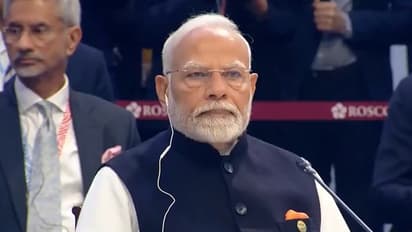BRICS Summit: After mega LAC deal, PM Modi, China's Xi Jinping hold first bilateral talks in 5 year

Synopsis
The relationship between the two most populous countries of the world has been escalated after talks between two countries in October last year, when Chinese President Xi Jinping met Indian Prime Minister Narendra Modi in Mahabalipuram.
Prime Minister Narendra Modi and Chinese President Xi Jinping on Wednesday (October 23) commenced discussions in Kazan, Russia, on the sidelines of the BRICS Summit. This meeting marks a significant diplomatic engagement between the leaders of two of the world's most populous nations amidst the broader discussions taking place at the summit.
The relationship between the two most populous countries of the world has been escalated after talks between two countries in October last year, when Chinese President Xi Jinping met PM Modi in Mahabalipuram. After this meeting, relations have worsened sharply following a hand-to-hand fight along the disputed Line of Actual Control in the Himalayan region of Ladakh in August 2020 that cost the lives of 20 Indian soldiers and an unspecified number of Chinese troops.
Key conflicts and tensions since 2019:
1. Doklam Standoff in 2017:
Through this conflict has taken place earlier before the elevation of tensions in 2019, the 73 day stand off near the trijunction of India, Bhutan and China was indicative of things to come. It was due to a road construction that China carried out on the disputed areas so the military tension was alerted on both sides.
2. Galwan Valley clash in 2020:
In May 2020, things worsened when there were friction points in various places along the LAC. This situation escalated to the Galwan Valley on June 15, 2020, in which collidivision led to killings of 20 Indian soldiers. This was the first lethal clash between the two coutries since the year 1975, it led a massive arsenal amassment on both sides.
3. Pangong Tso standoff (2020-2021):
Indian officials accused China of trying to change the status of Line of Actual Control positions in Pangong Tso region by their forces in August 2020. They signed an agreement in February 2021 pulling out of some installations after prolonged diplomatic negotiations.
4. Continued tensions in Depsang Plains and Gogra-Hot Springs (2021):
However, this disengagement has not altered a hostile ground situation, especially in Depsang Plains and Gogra-Hot Springs respectively. By July 2021, both sides decided to partial disengage in the Gogra section, but still, some issues are pending.
5. Tawang clash in Arunachal Pradesh (2022):
The second face-to-face took place in December 2022 at Tawang, Arunachal Pradesh, but it was a rare incident on the eastern sector. Despite having minor cases of injuries, the two factions were able to step down, an indication of a precarious relations between two parties.
Stay updated with the Breaking News Today and Latest News from across India and around the world. Get real-time updates, in-depth analysis, and comprehensive coverage of India News, World News, Indian Defence News, Kerala News, and Karnataka News. From politics to current affairs, follow every major story as it unfolds. Get real-time updates from IMD on major cities weather forecasts, including Rain alerts, Cyclone warnings, and temperature trends. Download the Asianet News Official App from the Android Play Store and iPhone App Store for accurate and timely news updates anytime, anywhere.